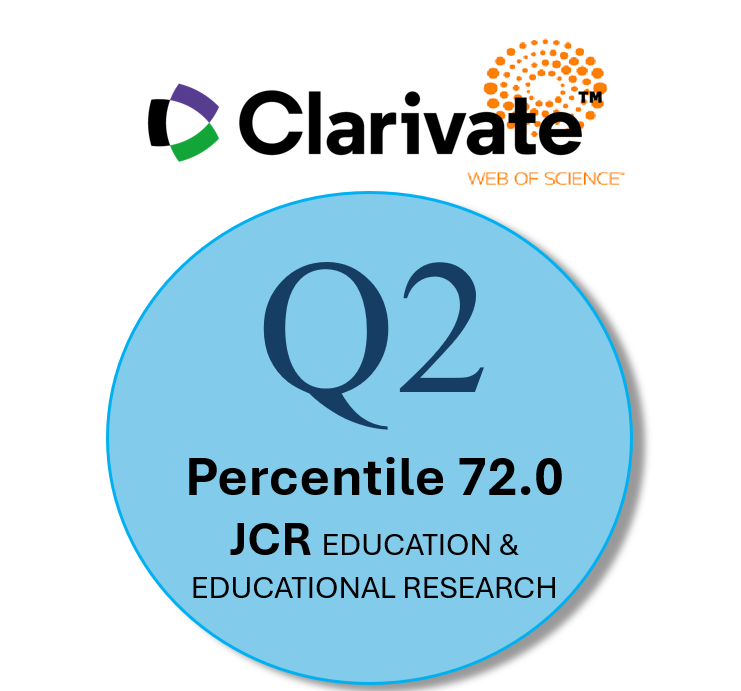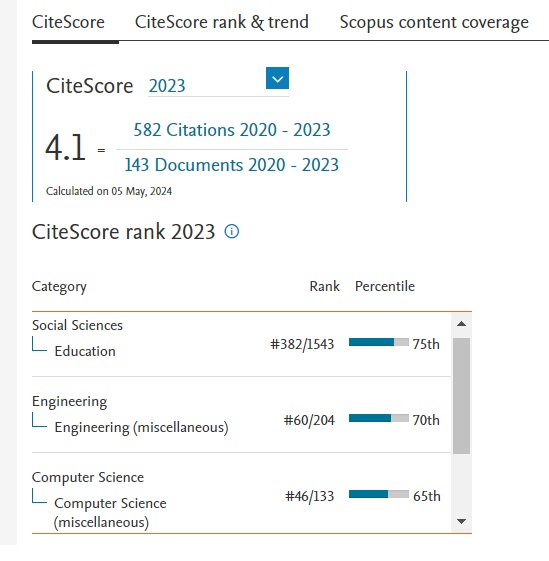LearningML: una herramienta para fomentar las habilidades de Pensamiento Computacional mediante proyectos prácticos de Inteligencia Artificial
Resumen
El uso de sistemas de inteligencia artificial en múltiples niveles de la sociedad ofrece nuevas y prósperas oportunidades, pero también introduce nuevos riesgos y cuestiones éticas que deben abordarse. Sostenemos que la introducción de contenidos de inteligencia artificial en las escuelas a través de proyectos prácticos es el camino a seguir para educar ciudadanos conscientes y críticos, para despertar vocaciones entre los jóvenes, y para fomentar las habilidades de pensamiento computacional de los estudiantes. Sin embargo, la mayoría de las plataformas educativas de programación existentes carecen de algunas características necesarias para desarrollar proyectos completos de IA y, en consecuencia, se requieren nuevas herramientas. En este artículo presentamos LearningML, una nueva plataforma dirigida al aprendizaje automático supervisado, una de las técnicas de IA más exitosas que se encuentra en la base de casi todas las aplicaciones actuales de IA. Este trabajo describe las principales funcionalidades de la herramienta y discute algunas decisiones tomadas durante su diseño, para el que hemos tenido en cuenta las lecciones aprendidas al revisar trabajos anteriores realizados para introducir la IA en la escuela y el análisis de otras soluciones que permiten proyectos prácticos de IA. También se presentan los próximos pasos en el desarrollo de LearningML, que se centran en la validación, tanto aparente como instruccional, de la herramienta.
Descargas
-
Resumen6165
-
PDF3079
Citas
Ali, S., Payne, B. H., Williams, R., Park, H. W., & Breazeal, C. (2019). Constructionism, Ethics, and Creativity: Developing Primary and Middle School Artificial Intelligence Education. 4.
Brennan, K., & Resnick, M. (2012). New frameworks for studying and assessing the development of computational thinking. Proceedings of the 2012 Annual Meeting of the American Educational Research Association. Vancouver: American Educational Research Association., 1, 25.
Brummelen, J. V., Shen, J. H., & Patton, E. W. (2019). The Popstar, the Poet, and the Grinch: Relating Artificial Intelligence to the Computational Thinking Framework with Block-based Coding. Proceedings of International Conference on Computational Thinking Education 2019. Hong Kong: The Education University of Hong Kong, 2.
Burton, E., Goldsmith, J., Koenig, S., Kuipers, B., Mattei, N., & Walsh, T. (2017). Ethical Considerations in Artificial Intelligence Courses. AI Magazine, 38(2), 22–34. https://doi.org/10.1609/aimag.v38i2.2731
Dahlbäck, N., Jönsson, A., & Ahrenberg, L. (1993). Wizard of Oz studies—Why and how. Knowledge-Based Systems, 6(4), 258–266. https://doi.org/10.1016/0950-7051(93)90017-N
Druga, S. (2018). GROWING UP WI TH AI Cognimates: From coding to teaching machines. Massachusetts Institute of Technology.
Estevez, J., Garate, G., & Graña, M. (2019). Gentle Introduction to Artificial Intelligence for High-School Students Using Scratch. IEEE Access, 7, 179027–179036. https://doi.org/10.1109/ACCESS.2019.2956136
Estevez, J., Garate, G., Guede, J. L., & Graña, M. (2019). Using Scratch to Teach Undergraduate Students’ Skills on Artificial Intelligence. ArXiv:1904.00296 [Cs]. http://arxiv.org/abs/1904.00296
Hein, G. (2016, January 6). Constructivist Learning Theory. Exploratorium. https://www.exploratorium.edu/education/ifi/constructivist-learning
Hitron, T., Orlev, Y., Wald, I., Shamir, A., Erel, H., & Zuckerman, O. (2019). Can Children Understand Machine Learning Concepts?: The Effect of Uncovering Black Boxes. Proceedings of the 2019 CHI Conference on Human Factors in Computing Systems - CHI ’19, 1–11. https://doi.org/10.1145/3290605.3300645
Hitron, T., Wald, I., Erel, H., & Zuckerman, O. (2018). Introducing Children to Machine Learning Concepts Through Hands-on Experience. Proceedings of the 17th ACM Conference on Interaction Design and Children, 563–568. https://doi.org/10.1145/3202185.3210776
Kahn, K., & Winters, N. (2017). Child-Friendly Programming Interfaces to AI Cloud Services. In É. Lavoué, H. Drachsler, K. Verbert, J. Broisin, & M. Pérez-Sanagustín (Eds.), Data Driven Approaches in Digital Education (pp. 566–570). Springer International Publishing. https://doi.org/10.1007/978-3-319-66610-5_64
Lane, D. (2018). Explaining Artificial Intelligence. Hello World, 4, 44–46.
Malyn-Smith, J., Lee, I. A., Martin, F., Grover, S., Evans, M. A., & Pillai, S. (2018). Developing a Framework for Computational Thinking from a Disciplinary Perspective. Proceedings of the International Conference on Computational Thinking Education 2018. Hong Kong: The Education University of Hong Kong, 5.
McCarthy, J., Minsky, M. L., Rochester, N., & Shannon, C. E. (1955, August 31). A Proposal for the Dartmouth Summer Research Project on Artificial Intelligence.
Ministerio de Ciencia, Innovación y Universidades. (2019). Estrategia Española de I+D+I En Inteligencia Artificial. Ministerio de Ciencia, Innovación y Universidades, 2019. Gobierno de España. http://www.ciencia.gob.es/stfls/MICINN/Ciencia/Ficheros/Estrategia_Inteligencia_Artificial_IDI.pdf
Moreno, J., Robles, G., Román, M., & Rodríguez, J. D. (2019). No es lo mismo: Un análisis de red de texto sobre definiciones de pensamiento computacional para estudiar su relación con la programación informática: Not the same: a text network analysis on computational thinking definitions to study its relationship with computer programming. Revista Interuniversitaria de Investigación En Tecnología Educativa. https://doi.org/10.6018/riite.397151
Pedró Francesc, Subosa Miguel, RIvas Axel, & Valverde Paula. (2019). Artificial intelligence in education: Challenges and opportunities for sustainable development—UNESCO Biblioteca Digital (UNESCO Working Papers on Education Policy). UNESCO. https://unesdoc.unesco.org/ark:/48223/pf0000366994?locale=es
Resnick, M., Silverman, B., Kafai, Y., Maloney, J., Monroy-Hernández, A., Rusk, N., Eastmond, E., Brennan, K., Millner, A., Rosenbaum, E., & Silver, J. (2009). Scratch: Programming for all. Communications of the ACM, 52(11), 60. https://doi.org/10.1145/1592761.1592779
Rodríguez-García, J. D., Moreno-León, J., Román-González, M., & Robles, G. (2019). Developing Computational Thinking at School with Machine Learning: An exploration. 6.
Simmons, C., & Holliday, M. A. (2019). A Comparison of Two Popular Machine Learning Frameworks. The Journal of Computing Sciences in Colleges.
Tang, D. (2019). Empowering novices to understand and use machine learning with personalized image classification models, intuitive analysis tools, and MIT App Inventor [Thesis, Massachusetts Institute of Technology]. https://dspace.mit.edu/handle/1721.1/123130
The Design-Based Research Collective. (2003). Design-Based Research: An Emerging Paradigm for Educational Inquiry. Educational Researcher, 32(1), 5–8. https://doi.org/10.3102/0013189X032001005
Touretzky, D., Gardner-McCune, C., Martin, F., & Seehorn, D. (2019). Envisioning AI for K-12: What Should Every Child Know about AI? Proceedings of the AAAI Conference on Artificial Intelligence, 33, 9795–9799. https://doi.org/10.1609/aaai.v33i01.33019795
Touretzkyds/ai4k12. (n.d.). GitHub. Retrieved 7 January 2020, from https://github.com/touretzkyds/ai4k12
Tuomi Ilkka. (2019). The Impact of Artificial Intelligence on Learning, Teaching, and Education. Joint Research Centre (JRC). European Union. http://publications.jrc.ec.europa.eu/repository/bitstream/JRC113226/jrc113226_jrcb4_the_impact_of_artificial_intelligence_on_learning_final_2.pdf
Las obras que se publican en esta revista están sujetas a los siguientes términos:
1. El Servicio de Publicaciones de la Universidad de Murcia (la editorial) conserva los derechos patrimoniales (copyright) de las obras publicadas, y favorece y permite la reutilización de las mismas bajo la licencia de uso indicada en el punto 2.
2. Las obras se publican en la edición electrónica de la revista bajo una licencia Creative Commons Reconocimiento-NoComercial-SinObraDerivada 3.0 España (texto legal). Se pueden copiar, usar, difundir, transmitir y exponer públicamente, siempre que: i) se cite la autoría y la fuente original de su publicación (revista, editorial y URL de la obra); ii) no se usen para fines comerciales; iii) se mencione la existencia y especificaciones de esta licencia de uso.
3. Condiciones de auto-archivo. Se permite y se anima a los autores a difundir electrónicamente las versiones pre-print (versión antes de ser evaluada) y/o post-print (versión evaluada y aceptada para su publicación) de sus obras antes de su publicación, ya que favorece su circulación y difusión más temprana y con ello un posible aumento en su citación y alcance entre la comunidad académica. Color RoMEO: verde.














